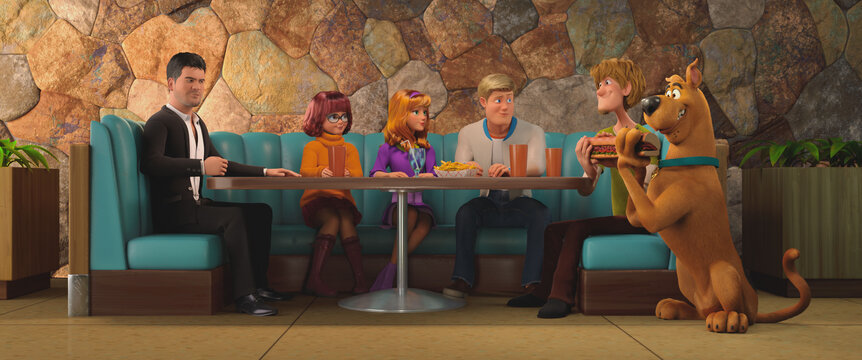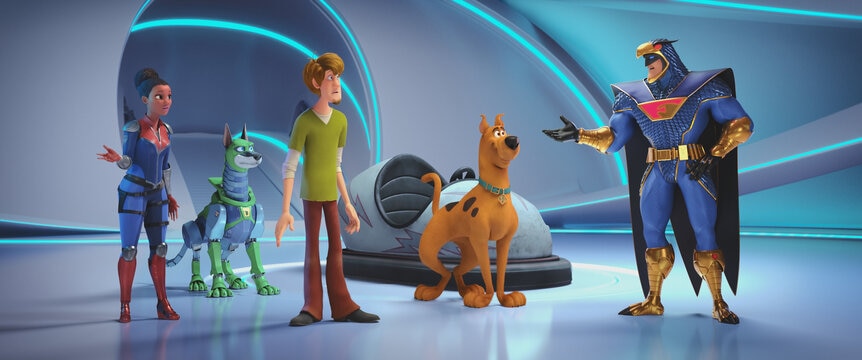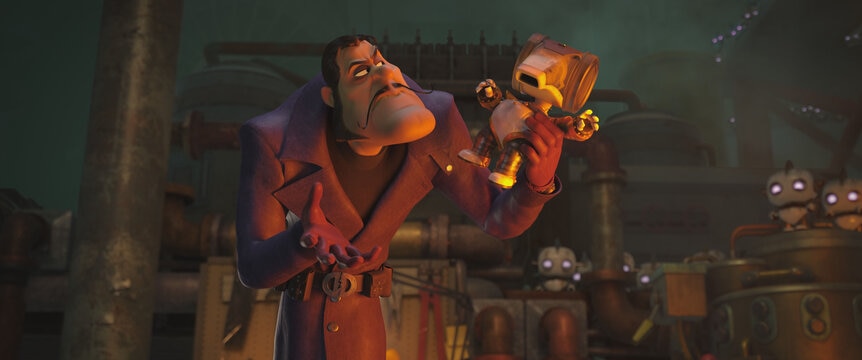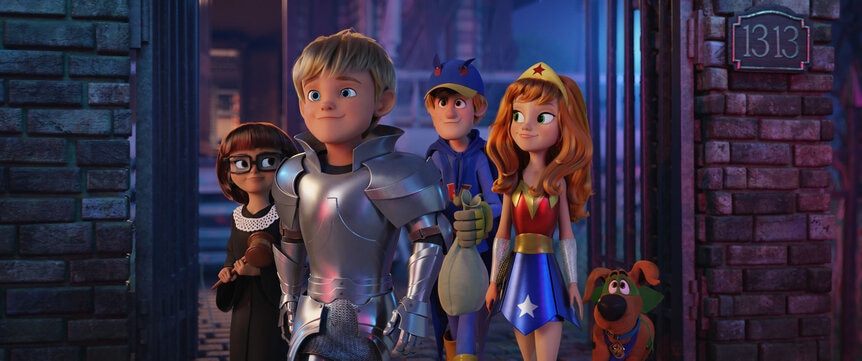Create a free profile to get unlimited access to exclusive videos, sweepstakes, and more!
Scoob! director reveals the big mysteries behind Scooby-Doo’s latest, greatest caper
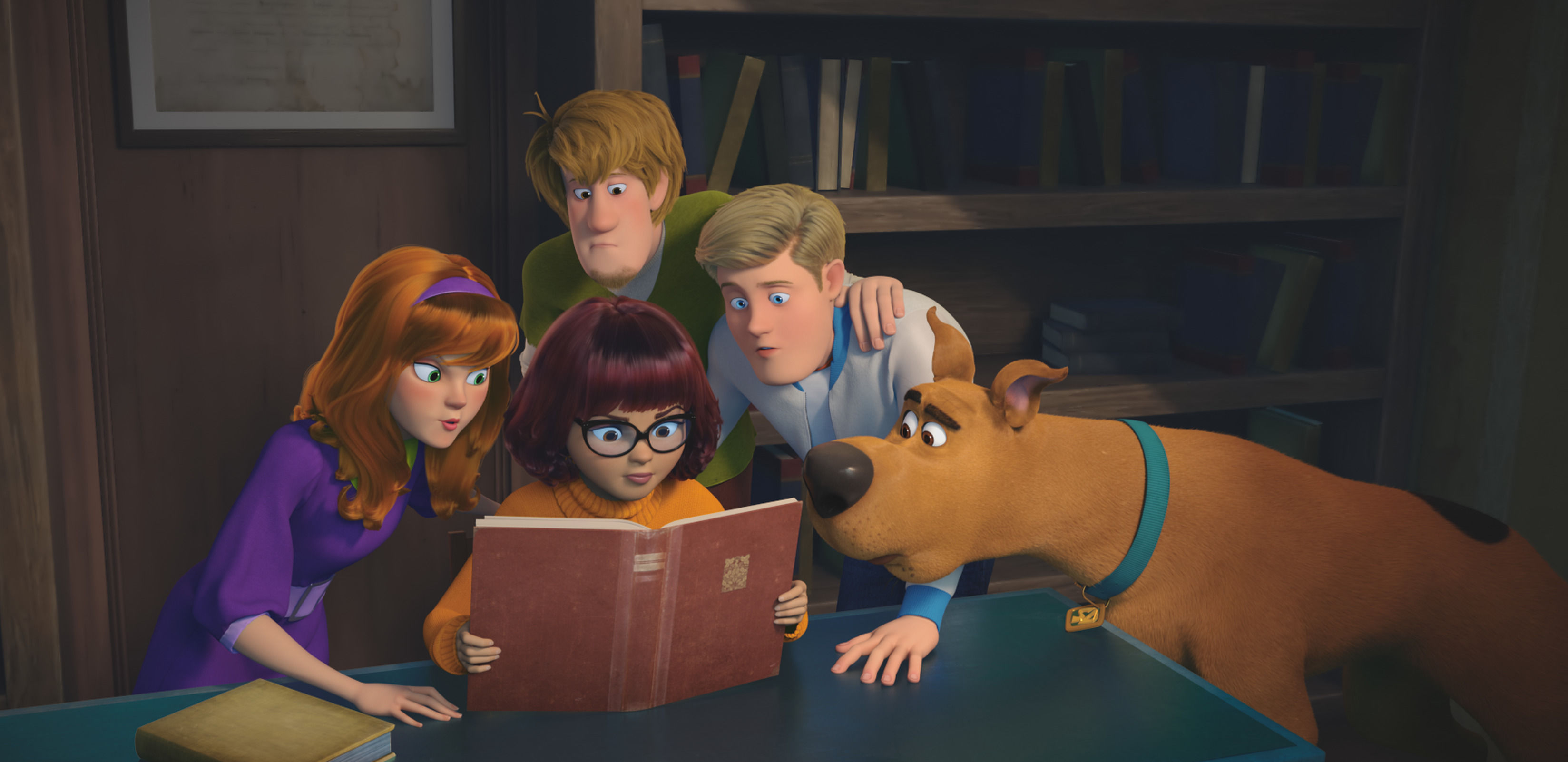
Scoob!, which is now available on digital and VOD, is not only the latest addition to the Scooby-Doo canon — it's also a love letter to the prolific animation studio that created the original series all the way back in 1969. The Mystery, Inc. gang aren't the only classic Hanna-Barbera characters running around. Other, more-forgotten characters like Dick Dastardly, Blue Falcon, Dynomutt, and Captain Caveman are part of the adventure, too, which meant that director Tony Cervone had a lot on his plate.
The film, which was originally scheduled for a theatrical release prior to the pandemic, is the first feature-length animated Doo! movie. Scoob! follows the gang as they uncover a dastardly plot to unleash the three-headed ghost dog, Cerberus, upon the world. Add in some supernatural mythology about Scooby's backstory and you've yourself got an adventure that shares a tiny bit of doggy DNA with the franchise's first live-action outing in 2002.
Cervone is a seasoned Warner Bros. Animation vet. He directed a number of straight-to-video films (such as Scooby-Doo! And Kiss: Rock and Roll Mystery and Scooby-Doo! Abracadabra-Doo) and co-created the Scooby-Doo! Mystery Incorporated TV show on Cartoon Network. That's a lot of Doo, and it made Mr. Cervone the perfect candidate for Scoob!
Following our own trail of clues, SYFY WIRE called up the director for a jinkies-inducing chat about the movie's large-scale production, Scooby-Doo on Zombie Island (a true classic!), and the series' lasting impact over the last five decades. Like, zoinks, man, just read the interview already!
***WARNING! The following contains minor plot spoilers for Scoob!***
You’re obviously no stranger to the Scooby-Doo universe, but how did the job of directing Scoob! differ from what you’ve done before with the property?
Primarily, the sense of scale. This is a feature film experience, so we had resources and time that we were able to devote to this movie that would’ve been really hard to do on a TV schedule. This is even bigger than the live-action movies, it’s the biggest Scooby-Doo story ever told. It is a biblical-sized version of Scooby-Doo.
Going off that, the movie does a lot to build up Scooby as this kind of grand, mythical figure. How did you decide that that would be the case?
This is the biggest mystery and the biggest adventure [the gang's] ever been on. But the most important to us was the personal story, Scooby and Shaggy’s story. The story of their friendship and what they go through and how they support each other and how they grow and change as people, but still remain friends.
All that stuff was the thing we spent most of our time on; it’s what the movie spends most of its time on. That’s why the origin is important, seeing that moment where they first meet and under what those conditions were and what they did for each other.
It's not just Scooby-Doo! characters in this film. You've got Blue Falcon, Dick Dastardly, and Dynomutt, to name a few. How did you choose which classic characters would help launch this "Hanna-Barbera Cinematic Universe”?
At one point, we actually had more Hanna-Barbara characters in the movie than [the number] we ended up with. During the course of making the movie and working on the story, they were stealing time away from Scooby and Shaggy, so there were a few characters that lived in the movie for a long time that we even built and everything, but they were starting to distract more than they were adding to the film.
You talked about nailing the bigger sense of scale, but there's also a responsibility of making the Mystery Inc. gang relevant for modern audiences. What was the process for achieving that?
It was really important to be modern and tell a modern story, but also to honor and be respectful to the characters as they are. Blue Falcon’s a different Blue Falcon than existed in the classic TV show, but that character still exists. He’s out there. In our head, the father of Blue Falcon is the guy you knew from the old show ... The [Mystery, Inc.] gang has been updated many times over the years. I think it’s always successful because there’s always gonna be a brain, a heart, and a muscle.
You gotta keep the core of the characters the same, but then it’s also to push and pull them a little bit. We also had a great cast and their personalities matched the personalities of the characters ... We wanted all of them to explore a little bit and bring themselves to these roles. It was really important to do that. These are talented people [and] it’s like, "Why wouldn’t we take advantage of it?"
Speaking of, are there any fun behind-the-scenes anecdotes from the recording process that stand out in your mind?
Everyone really liked to add things and then once you start recording with people — and we don’t do it in a weekend — it takes probably a year [to] a year-and-a-half to record all the voices because you do it for a while, then you come back a few months later, and you try things out.
Once the actors got into the characters, the characters changed a little bit as well. Like, Ken Jeong brought a lot to Dynomutt. We talked a lot about what Dynomutt is personally thinking and what he’s feeling, so it’s a very organic process and there’s a lot of back and forth.
I had a great time with Jason Isaacs as Dick Dastardly and he was incredibly important and brilliant in [transforming] a character, who’s great but doesn’t have a ton of depth. We had a lot of discussions about, "How do we make this a real person? How do we make this still the Dick Dastardly you love, but give him some real emotions? What is really driving this guy?" And [then] give him a depth that I don’t think he had before, and a lot of that is Jason. And a lot of that is not just his voice, it’s his brain.
All that stuff is super important and there’s a lot of back and forth. And with Mark Wahlberg (Blue Falcon), too. A lot of that is, "Hey, Mark, do you think of this?" [And he's like,] "Oh well, I like that, why don’t we try that?" Once the cast kind of settles in, it really changes everything and you want to be as inclusive as you can.
What, to you, makes Scooby-Doo such a lasting series?
Their friendship as a group, especially between Scooby and Shaggy, I think is important. It’s something that people like to watch. You like spending time with Scooby and Shaggy — they’re funny and they’re fun and they seem to really like each other and it’s nice to see ...
But then there’s also the elements of mystery-solving and monsters and debunking and meddling kids. I think that’s very important, [them] doing something they shouldn’t be doing. They’re not law enforcement officers, they’re a bunch of kids sneaking into windmills and going places they shouldn’t even be to solve a mystery that no one asked them to solve.
I think all of those things are important and it’s fun watching kids be right. The young people are right and all the adults seem to believe that that the ghost is real or that monster is real, but it’s [these] meddling kids who know better. All of those things, I think, are really rewarding and fun to watch.
Since you brought it up, Scoob! does bring in some genuine supernatural elements. Do you think that "making the monster real" is needed to justify a feature-length film?
Some of it is [derived from] when did you grow up? That question really depends on, "What is your Scooby-Doo?" My Scooby-Doo, personally, is [that the ghost or monster] was always fake. But it started being real monsters in Zombie Island in the ‘90s ...
There are whole generations that [grew] up close to Zombie Island who think it’s totally ok that sometimes, monsters are real. For a modern audience, they’re totally accepting that sometimes they’re real, sometimes they’re not. I’m kind of old school, so it still is always a little weird to me. But what I like about this movie is we have our cake and eat it too We have guys in masks as well.
I’m of the Zombie Island generation and I think you did a great job.
Zombie Island was awesome. And in [Scooby-Doo! Mystery Incorporated], we had real stuff and fake stuff. And our real stuff was really terrifying.
Since the movie is going straight to digital, what makes it good viewing for the pandemic era?
We’re in this situation and I think this is good for that. I don’t wanna [be too pretentious]. It’s a cartoon dog movie, but this is a time when something like that — just taking a 90-minute break and watching something fun and bright and colorful and silly and heartwarming and exciting — I think it’s good. It’s good medicine right now and I think that the timing of this, releasing it now, when there’s families and fans who can get something from this, I think it’s important and I think it’s the right thing to do.
